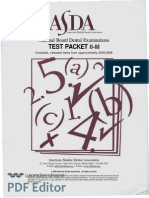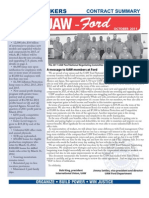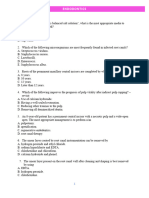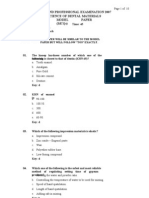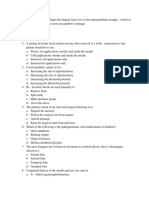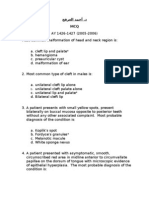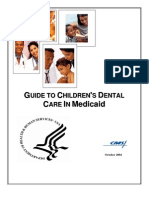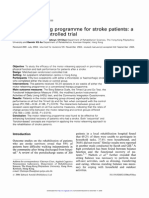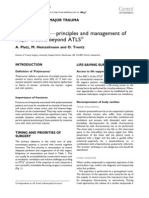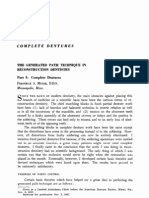Dr. Ahmed Al-Arfaj MCQ
Dr. Ahmed Al-Arfaj MCQ
Uploaded by
yalahopaCopyright:
Available Formats
Dr. Ahmed Al-Arfaj MCQ
Dr. Ahmed Al-Arfaj MCQ
Uploaded by
yalahopaOriginal Description:
Copyright
Available Formats
Share this document
Did you find this document useful?
Is this content inappropriate?
Copyright:
Available Formats
Dr. Ahmed Al-Arfaj MCQ
Dr. Ahmed Al-Arfaj MCQ
Uploaded by
yalahopaCopyright:
Available Formats
MCQ DR. AHMED AL-ARFAJ AY 1426-1427 (2005-2006) 1. Most common malformation of head and neck region is: a. b. c. d.
cleft lip and palate* hemangioma preauricular cyst malformation of ear
2. Most common type of cleft in males is: a. b. c. d. unilateral cleft lip alone unilateral cleft palate alone unilateral lip and palate* Bilateral cleft lip
3. A patient presents with small yellow spots, present bilaterally on buccal mucosa opposite to posterior teeth without any other associated complaint. Most probable diagnosis of the condition is: a. b. c. d. Kopliks spot Fordyces granules* Melanotic macule White sponge nevus
4. A patient presented with asymptomatic, smooth, circumscribed red area in midline anterior to circumvallate papillae on the dorsum of tongue with microscopic evidence of epithelial hyperplasia. The most probable diagnosis of the condition is: a. b. c. d. geographic tongue hairy tongue median rhomboid glossitis* lingual thyroid
5. In hairy tongue, there is hypertrophy of: a. b. c. d. fungiform papillae filiform papillae* foliate papillae circumvallate papillae
6. A patient present with an asymptomatic soft, fluctuant swelling of the angle of mandible anterior to sternocleido-mastoid muscle which he stated to be present since his childhood days. Regional lymph nodes are nonpalpable with normal radiographic pictures of the area and normal blood and urine examination. Aspiration of swelling shows yellow-brown fluid. Most probable diagnosis in the condition is: a. b. c. d. thyroglossal duct cyst salivary gland tumor branchial cleft cyst* follicular ameloblastoma
7. Which of the following condition is characterized by generalized intestinal polyposis with pigmentation of face and oral mucosa: a. b. c. d. Peutz-Jeghens syndrome* Albright syndrome Gardner syndrome Neurofibromatosis
8. A 25-year al patient presents with an asymptomatic doughy soft, fluctuant swelling on lateral neck which was present for month but recently enlarged following an upper respiratory tract infection. Most likely diagnosis of the swelling is: a. b. c. d. scrofula lymphoma cervicofacial actinomycosis cervical lymphoepithelial cyst*
9. Most characteristic histopathologic feature of keratoacanthoma is: a. elevation of normal epithelium towards the central portion of the lesion with an abrupt change in normal epithelium as hyperplastic acanthotic epithelium is reached* b. hyperplastic squamous epithelium growing into underlying connective tissue c. occasional dysplastic features d. epithelium appears to be invading into connective tissue at deep leading margin of the tumor 10. A patient reported with an asympthomatic white patch on buccal mucosa which cannot be rubbed off. The patch was present for the last 3 months. Patient is a heavy cigarette smoker. Most probable diagnosis of the lesion is: a. b. c. d. Leukoplasia* Candidiasis Erythroplakia White sponge nevus 2
11. Site most commonly affected by basal cell carcinoma is: a. b. c. d. buccal mucosa skin of palm and exposed surface of arms skin of upper back area skin of middle third of face*
12. A patient with history of tobacco chewing presents with an asymptomatic, exophytic papillary growth on right buccal mucosa. Histologic examination of the lesion reveal marked epit helial proliferation without invasion into the connective tissue and parakeratin plugging. Most probable diagnosis is: a. b. c. d. epidermoid carcinoma basal cell carcinoma papilloma verrucous carcinoma*
13. A patient present with tender swelling in the palatal area. Associated teeth were normal. Radiographic examination of the area shows radiolucent area with honeycomb appearance. Excessive bleeding was encountered upon entering into the lesion. Most probable diagnosis of the lesion is: a. b. c. d. radicular cyst aneurysmal bone cyst* hemorrhagic bone cyst mid-palatal cyst
14. Skin lesions of the hereditary hemorrhagic telangiectasia are most common on: a. b. c. d. arms abdomen legs face*
15. Characteristic hemorrhagic lesions of the hereditary hemorrhagic telangiectasia occurs most often on a. b. c. d. Tongue Lips* Gingival Palate
16. A 70-year old patient present with small, elevated, crusted lesion on right side of nose which he stated to be present for last several months and never quite heals. The most likely diagnosis is: a. b. c. d. Epidermoid carcinoma Verrucous carcinoma Sebaceous cyst Basal cell carcinoma* 3
17. A patient presents with a bilateral greyish white lesion on buccal mucosa which disappear when stretched. The most likely diagnosis is: a. b. c. d. Lichen planus Leukoplakia Leukoedema* White sponge nevus
18. All of the following diseases has been associated with Epstein-Barr virus EXCEPT: a. b. c. d. Burkitts lymphoma Malignant mixed tumor Oral hairy leukoplakia* Infectious mononucleosis
19. An elderly anemic patient complains of back pain. Numerous punched out radiolucencies are evident on skull radiograph. The patient should be suspected of having: a. b. c. d. Ewings sarcoma Thalassaemia Multiple myeloma* Malignant lymphoma
20. Basal cell carcinoma frequently involves normal tissues by spreading by way of: a. b. c. d. lymphatics arteries nerve sheaths direct invasion*
21. A benign neoplasm which appears as a non-painful slowly enlarging, submucosal mass with overlying epithelium exhibiting pseudoepitheliomatous hyperplasia is most likely a: a. b. c. d. fibroma granular cell tumor* papilloma keratoacanthoma
22. Examination of a child shows enlargement of left side of tongue showing small, elevated greyish-pink nodules some of which are fluid filled with rest of oral cavity being normal. Most likely diagnosis of the lesion is: a. b. c. d. neurofibromatosis lymphangioma* granular cell myoblastoma cystic fibrosis
23. Biopsy of a smooth, red, protruding lesion at lateral, border of tongue shows stratified squamous epithelium covering loose connective tissue that contains many thin-walled engorged, vascular space. Most likely diagnosis is: a. b. c. d. papilloma hemangioma* lymphangioma granular cell myoblastoma
24. Multiple lesions seen in patients suffering from von Recklinghaussens disease of skin are: a. b. c. d. neurofibromas* neurolemmomas hemangiomas griant cell tumors
25. Most common site of occurrence of salivary gland tumors is a. b. c. d. parotid gland* sub-maxillary gland sub-lingual gland minor salivary gland
26. Primary Sjogrens syndrome consists of keratoconjunctivitis sicca and: a. b. c. d. Xerostomia* Rheumatoid arthritis SLE Scleroderma
27. Triad of Sjogren syndrome consists of: a. b. c. d. conjunctivitis, stomatitis, rheumatoid arthritis keratoconjunctivitis, xerostomia, rherumatoid arthritis* keratoconjunctivitis, xerostomia, osteoarthritis conjunctivitis, stomatitis, urethritis
28. Radiographic appearance of salivary glands in Sjogrens syndrome is characteristically described as: a. b. c. d. sun-ray appearance cherry-blossom or branchless fruit laden tree appearance* honeycomb appearance onion-peel appearance
29. Patients affected by Sjogrens syndrome shows increased incidence of development of: a. b. c. d. osteosarcoma lymphoma* multiple myeloma adenocarcinoma 5
30. Majority of lymphomas developed in patients of Sjogens syndrome are of: a. b. c. d. Hodgkins lymphoma Burkitts lymphoma Non-hodgkin lymphoma of B-cell origin* Non-hodgkin lymphoma of T-cell origin
31. The common site of occurrence of adenoid cystic carcinoma is: a. b. c. d. parotid gland* palatal mucosa upper lip sub-mandibular gland
32. Most suggested etiology of necrotizing sialometaplasia is: a. b. c. d. trauma infection ischaemia* neoplastic changes
33. Which of the following salivary gland neoplasm is least likely to be found in minor salivary glands a. b. c. d. papillary cystadenoma lymphomatosum* adenoid cycstic carcinoma mucoepidermoid carcinoma pleomorphic adenoma
34. A 40-year old woman reports the development of painful crater like ulcer on mucosa of left hard palate within one week following the extraction of maxillary left second premolar. Most likely diagnosis is: a. b. c. d. pleomorphic adenoma squamous cell carcinoma necrotizing sialometaplasia* adenoid cystic carcinoma
35. An elderly woman present with swelling of lateral aspect of left side of neck which was present for last ten months but start increasing in size for the last two months and is now painful. There is small ulceration of skin overlying the mass with distortion of left facial region when patient speaks. Differential diagnosis will include all of the following EXCEPT: a. b. c. d. adenoid cystic carcinoma pleomorphic adenoma* mucoepidermoid carcinoma malignant mixed tumor
36. Toxin produced by streptococci which is responsible for causing scarlet fever is: a. b. c. d. first day illness second or third day of illness* fifth to seventh day of illness one week after appearance of other clinical signs and symptoms
37. In miliary tuberculosis, dissemination of microorganism occur usually via: a. b. c. d. lymphatics blood streams* saliva pulmonary fluid
38. A patient presents with mild fever, sore throat and ulceration of fascial pillars, posterior pharyngeal wall and soft palate. Most likely diagnosis is: a. b. c. d. Reiter syndrome Herpangina* Herpetis gingivostomatitis Recurrent rhomboid glossitis
39. A patient on antibiotic therapy for scarlet fever develops white plaques on his oral mucosa which when scraped with tongue blade leaves a painful bleeding surface, most probable diagnosis is: a. b. c. d. Blastomycosis Candidiasis* Herpes simplex infection Syphilis
40. Which of the following is most opportunistic infection? a. b. c. d. Candidiasis* Actinomycosis Histoplasmosis Blastomycosis
41. Sulfur granules are of diagnostic value is suspected cases of: a. b. c. d. Candidiasis Tuberculosis Actinomycosis* Histoplasmosis
42. A patient presents with slightly painful white lesions of oral mucosa which when wiped off shows the red surface underneath. The patient is on penicillin therapy for last 12 weeks. The most likely diagnosis of lesion is: a. b. c. d. Actinomycosis Candidiasis* Lichen planus Leukoplakia 7
43. Clinical diagnosis of candidiasis is confirmed by: a. response to vitamin B12 therapy b. demonstration of mycelia and spores on histologic examination of scrapings* c. sun-ray arrangement of fungal hyphae d. presence of characteristic sulfur granules 44. A patient with severe mycotic infection of head and neck characterized by triad of uncontrolled diabetes, orbital infection and meningoencephalitis most probably has: a. b. c. d. Candidiasis Actinomycosis Mucormycosis* Histoplasmosis
45. The organism most commonly implicated as causative agents in cases of cellulites is: a. b. c. d. Staphylococcus sp. Streptococcus sp.* Neisseria sp Pheumococcus sp.
46. A middle age patient presents swelling in the left maxillary area with mild pain on palpation. On examination, left maxillary first molar was missing and patient gives the history of traumatic extraction of the tooth about 10 year ago in which one of the root was displaced in the maxillary sinus which was then removed via Caldwell-Luc operation. Overlying skin and other teeth were normal. X-ray examination shows a radiolucent are in left maxilla which was separated from left maxillary sinus anatomically. Most probable diagnosis of the condition is: a. b. c. d. surgical ciliated cyst of maxilla* maxillary sinusitis carcinoma of maxillary antrum retention cyst of maxillary sinus
47. A patient presents with swelling in neck near the angle of mandible on right side which disappear on applying pressure to it. Intraorally a dome-shaped, bluish swelling present in floor of mouth on right side. Most likely diagnosis of the lesion is: a. b. c. d. mucocele dermoid cyst branchial cyst ranula*
48. Sialoliths are mainly composed of: a. b. c. d. calcium phosphate* calcium oxide calcium carbonate calcium suphate
49. Which of the following cells are most radioresistant? a. b. c. d. granulocyte muscle cell lymphocyte epithelial cell*
50. Which of the following tissue is mot sensitive to radiation induced carcinogenesis? a. b. c. d. Thyroid* liver salivary gland brain
51. Craniofacial dysostosis with syndactyly is also known as: a. b. c. d. Crouzons syndrome Apert syndrome* Treacher Collins syndrome Eranceschetti syndrome
52. Triangular frontal defect, parrots beak nose, hypertelorism and prognathic mandible are features of: a. b. c. d. mandibulofacial dysostosis craniofacial dysostosis* Pierre Robin syndrome Cleidocranial dysostosis
53. A female patient complains of pain in right ear radiating towards the angle of mandible. Clicking sounds were present in right temporomandibular joint. Results of palpation and radiographic examination are negative. The most probable diagnosis is: a. b. c. d. osteoarthritis rheumatoid arthritis myofacial pain dysfunction syndrome* traumatic arthritis
54. Which of the following groups of lymph nodes is first to exhibit lymphadenopathy in cases of infection monocucleous? a. b. c. d. axillary cervical* inguinal mediastinal 9
55. An early oral manifestation of infectious mononucleosis is; a. b. c. d. palatal petechiae* oral ulceration inflammation of mucous membrane edema of soft palate and uvula
56. Philadelphia chromosome is characteristically seen in: a. b. c. d. acute lymphocytic leukaemia acute monocytic leukaemia chronic lymphocytic leukaemia chronic myeloid leukaemia*
57. Most common form of leukaemia in children is: a. b. c. d. acute lymphocytic leukaemia* chronic myeloid leukaemia acute monocytic leukaemia chronic lymphocytic leukaemia
58. In thrombocytopenic purpura: a. b. c. d. bleeding time is normal, clotting time is prolonged Both bleeding and clotting time are prolonged Bleeding time is prolonged, clotting time is normal* Both bleeding time and clotting time are norma
59. Hemophilia A is caused to deficiency of: a. Factor VIII* b. Factor IX c. Factor V d. Factor X 60. In hemophilia A: a. Prothrombine time (PT) is normal, plasma thromboplastin time (PTT) is normal b. PT is prolonged, PTT is prolonged c. PT is normal, PTT is prolonged* d. PT is prolonged, PTT is normal 61. A patient presents with spontaneous necrotizing ulcers of oral cavity. On laboratory examination, RBC count was normal but WBC count was 2,000 with lymphocytes 65% neutrophils 5%, monocytes 28%, eosinophils 2% and basophils 0%. The most likely diagnosis is: a. b. c. d. infectious mononucleosis agranulocytosis* cyclic neutropenia leukaemia 10
62. A patient presents with petechiae on oral mucosa with gingival bleeding. Blood examination shows platelet count of 30,000/mm3 with increase in bleeding time and clot retraction time, RBC, TLC are normal. Most probable diagnosis is: a. b. c. d. hemophilia infectious mononucleosis thrombocytopenic purpura* anemia
63. A middle-aged patient complains of periodic burning of her buccal mucosa. Oral examination shows slightly raised, linear, grayish-white plaque on buccal mucosa. Biopsy of the lesion shows acanthosis, surface keratosis with vacuolation of cells of basal cell layer with cellular inflammatory infiltrate localized to subepithelial connective tissue. Most likely diagnosis is: a. b. c. d. Lichen planus* Leokoedema Luekoplakia Pemphigoid
64. Sudden development of intensely red, wheal-like lesions on oral mucosa which progress to form thin-walled vesicles which ruptures to form ulceration covered by yellowish-white membrane suggests a diagnosis of: a. b. c. d. Reiters syndrome Behcets syndrome Erythema multiforme* Pemphigus
65. A patient presents with an asymptomatic white corrugated patch present bilaterally on his buccal mucosa. He also reports the occurrence of same kind of lesion in his mother and younger brother. Most likely diagnosis is: a. b. c. d. Pemphigus Leukoedema Candidiasis White sponge nevus*
66. An elderly patient complains of burning, aching pain, paresthesia, and itching on one side of face. On examination, small white scars are seen in preauricular region. Most likely diagnosis is: a. b. c. d. Sphenopalalatine neuralgia Bells palsy Auriculotemporal syndrome Post-herpetic neuralgia*
11
67. Dysphagia, sore throat, pharyngeal pain which occurs due to elongated styloid process exerting pressure on pharyngeal wall is known as: a. b. c. d. Trotters syndrome Eagles syndrome* Glossopharyngeal neuralgia Orofacial dyskinesia
68. A patient presents with an asymptomatic submucosal lump in his tongue. On histopathologic examination, it shows cells with extremely granular eosinophillic cytoplasm. Pseudoepitheliomatous hyperplasia was also present. Most likely diagnosis of the lesion is: a. b. c. d. lymphangioma granular cell myoblastoma* hemangioma lingual thyroid
69. In which of the following condition, serum alkaline phosphatase levels are increased? a. b. c. d. Paget;s disease* Osteogenesis imperfecta Osteopetrosis Cherubism
70. Diffuse white lesions are seen in the mouth of a 6-month old child who is on antibiotic therapy for the cystic fibrosis. The white patches could be stripped off leaving a raw, red surface. The most likely diagnosis of the condition is: a. b. c. d. acute herpetic stomatitis diphtheria oral thrush* herpangina
12
You might also like
- Disability Support Pension Claim FormsDocument11 pagesDisability Support Pension Claim Formscurtisbrown89No ratings yet
- Nbde Ii - Test Packet II-m (2000-2008)Document35 pagesNbde Ii - Test Packet II-m (2000-2008)yalahopa95% (19)
- Retina/Vitreous: Question 1 of 130Document51 pagesRetina/Vitreous: Question 1 of 130safasayed100% (1)
- Occlusion MCQDocument41 pagesOcclusion MCQAmar Bhochhibhoya75% (32)
- ELC590 Persuasive SpeechDocument5 pagesELC590 Persuasive SpeechmypinkladyNo ratings yet
- - الملف الذهبي رقم 1+2 CorrectedDocument49 pages- الملف الذهبي رقم 1+2 Correctedmohammed alsaad100% (1)
- OSODROENTDocument82 pagesOSODROENTAvner TolentinoNo ratings yet
- September 2004 Paper2Document10 pagesSeptember 2004 Paper2api-26291651100% (2)
- كل أسئلة اللثة لامتحان الهيئةDocument40 pagesكل أسئلة اللثة لامتحان الهيئةMohamed Kudaih100% (1)
- Prostho Fix 10Document16 pagesProstho Fix 10Priya SargunanNo ratings yet
- UAW Ford Contract SummaryDocument24 pagesUAW Ford Contract SummaryCourier JournalNo ratings yet
- McqsDocument20 pagesMcqsAkinniyi100% (2)
- Children of Mothers With Borderline Personality Disorder (BPD)Document6 pagesChildren of Mothers With Borderline Personality Disorder (BPD)curiositykillcat100% (1)
- Oral Medicine Mcqs - ٠٧٠٠١٨Document5 pagesOral Medicine Mcqs - ٠٧٠٠١٨alshybanyalmz30No ratings yet
- Op MCQ - S by Dr. Arshad MalikDocument39 pagesOp MCQ - S by Dr. Arshad MalikMuhammad MesamNo ratings yet
- MCQs in Orofacial PainDocument41 pagesMCQs in Orofacial PainSara MohamedNo ratings yet
- Dentosphere World of Dentistry MCQs On Odontoge - 1608067888704Document13 pagesDentosphere World of Dentistry MCQs On Odontoge - 1608067888704Habeeb AL-AbsiNo ratings yet
- EASY QUESTIONS ON PERIODONTICS - Q AsDocument14 pagesEASY QUESTIONS ON PERIODONTICS - Q AsMeena KulkarniNo ratings yet
- 2009 Mid-Term Questions For Oral Pathology 1 Exclude Cyct Questions, Because They Are Not Included in Your Mid ExamDocument7 pages2009 Mid-Term Questions For Oral Pathology 1 Exclude Cyct Questions, Because They Are Not Included in Your Mid ExamPrince AhmedNo ratings yet
- PeriodonticsDocument42 pagesPeriodonticshudaNo ratings yet
- Perio MCQ 2011Document2 pagesPerio MCQ 2011Salem Rawashdah100% (1)
- 2014 Revision Questions - OziDent PDFDocument297 pages2014 Revision Questions - OziDent PDFMohsen Saeed OzaibiNo ratings yet
- MSC Question Part 1Document166 pagesMSC Question Part 1heyitsgiselleNo ratings yet
- Aiims 4 QuesDocument6 pagesAiims 4 QuesAyyagari Kameswar Rao67% (3)
- Mcqs of EndoDocument38 pagesMcqs of Endoمنير الجبريNo ratings yet
- Surgery SLE MCQDocument34 pagesSurgery SLE MCQAsif Newaz100% (1)
- Asma Naz - Bcqs For DR Dost Baloch (1) - 3Document41 pagesAsma Naz - Bcqs For DR Dost Baloch (1) - 3Arisha khan100% (1)
- TEST I. Multiple Choice. Choose and BOLD The Correct AnswerDocument7 pagesTEST I. Multiple Choice. Choose and BOLD The Correct AnswerCzarina Kaye100% (2)
- 2020 Y3T2 Oral and Maxillofacial Surgery Exam 1Document7 pages2020 Y3T2 Oral and Maxillofacial Surgery Exam 1Golbarani HomeNo ratings yet
- Mishaps MCQDocument8 pagesMishaps MCQBesHo TwadroUs0% (1)
- DCH Toothbook MCQ PerioDocument15 pagesDCH Toothbook MCQ PerioTabou Gastone100% (1)
- ENDODONTICS Student ShareDocument48 pagesENDODONTICS Student ShareAmasi AhmedNo ratings yet
- 2.corrected FB Questions Prometric-1Document186 pages2.corrected FB Questions Prometric-1Moaz AlbabaNo ratings yet
- MCQ - Test Oral Surgery: ST ND ND RD ST NDDocument4 pagesMCQ - Test Oral Surgery: ST ND ND RD ST NDAlshoaibi Alshoaibi100% (2)
- Post-Test Periodontology: Prepared By: Dr. Christian Galileo DavidDocument4 pagesPost-Test Periodontology: Prepared By: Dr. Christian Galileo DavidAlene Victoria SareNo ratings yet
- Final Oral Pathology ExamDocument5 pagesFinal Oral Pathology Examsolom islamNo ratings yet
- MCQ Final 1984Document19 pagesMCQ Final 1984JohnSonNo ratings yet
- Endo Don TicsDocument3 pagesEndo Don Ticsdrpnnreddy83% (6)
- ENDO Q&A Mosby PDFDocument7 pagesENDO Q&A Mosby PDFShikha100% (1)
- Bds Second Professional Examination 2007 Science of Dental Materials Model Paper (MCQS)Document11 pagesBds Second Professional Examination 2007 Science of Dental Materials Model Paper (MCQS)Shreta Sachdeva100% (2)
- MCQ Homework: PeriodonticsDocument4 pagesMCQ Homework: Periodonticsفراس الموسويNo ratings yet
- Exam MaterialsDocument38 pagesExam MaterialsLuQman GhaniNo ratings yet
- مزاولة مهنة - طب أسنان نوفمبر 2020Document5 pagesمزاولة مهنة - طب أسنان نوفمبر 2020وردة صبرNo ratings yet
- MCQ Final 2014Document19 pagesMCQ Final 2014JohnSon100% (1)
- 1Document21 pages1imtiyazh85100% (1)
- Dentosphere - World of Dentistry - MCQs in Endodontics - Disinfection and ObturationDocument14 pagesDentosphere - World of Dentistry - MCQs in Endodontics - Disinfection and Obturationbadr abdelkader100% (1)
- AHEAD Test and Discussions - IMPLANTOLOGYDocument9 pagesAHEAD Test and Discussions - IMPLANTOLOGYSagar LodhiaNo ratings yet
- Salivary Gland MCQDocument3 pagesSalivary Gland MCQsalahoveNo ratings yet
- DR Ashraf Gift To DR AlvaroDocument16 pagesDR Ashraf Gift To DR AlvaroAhmed Saleh100% (1)
- 1 - Cairo Uni - Final Revision MCQ PedoDocument43 pages1 - Cairo Uni - Final Revision MCQ PedoYugi El-yaddakNo ratings yet
- 349 DR - Alyaa 3-2016Document55 pages349 DR - Alyaa 3-2016Kartik R. MorjariaNo ratings yet
- Procedures Required Prior To Restoration MCQDocument7 pagesProcedures Required Prior To Restoration MCQSR Shots100% (2)
- Endo Exam Y3 T2 2020 1Document5 pagesEndo Exam Y3 T2 2020 1Golbarani Home100% (1)
- Perio QuestionsDocument32 pagesPerio QuestionsSoha Jan KhuhawarNo ratings yet
- MCQ Dental.Document5 pagesMCQ Dental.anuj sharmaNo ratings yet
- Sep 04 Paper 1 & 2Document15 pagesSep 04 Paper 1 & 2Farrukh Ali KhanNo ratings yet
- Traumatic InjuryDocument3 pagesTraumatic Injurymdio midoNo ratings yet
- Part 2 Rqs SolvedDocument26 pagesPart 2 Rqs Solvedananth josyulaNo ratings yet
- MCQ On Periapical LesionsDocument3 pagesMCQ On Periapical LesionsSally MohamadNo ratings yet
- Idoc - Pub - Oral Pathology Mcqs PDFDocument3 pagesIdoc - Pub - Oral Pathology Mcqs PDFardesh abdille0% (1)
- Endo Final ExamDocument6 pagesEndo Final ExamAhmed HusseinNo ratings yet
- كل أسئلة اللثة لامتحان الهيئةDocument41 pagesكل أسئلة اللثة لامتحان الهيئةMohamed KudaihNo ratings yet
- 3 RfajDocument81 pages3 RfajSheikhaNo ratings yet
- OMFS Question Bank-1Document55 pagesOMFS Question Bank-1Ahmed Saleh100% (1)
- Oral Medicine (WELLS)Document28 pagesOral Medicine (WELLS)Evansenire Requerme100% (2)
- O.M Final ExamDocument4 pagesO.M Final ExamAwilNo ratings yet
- 2017 Syllabus - MVH Modular Sedation SeriesDocument11 pages2017 Syllabus - MVH Modular Sedation SeriesyalahopaNo ratings yet
- Periodicity DentalGuideDocument52 pagesPeriodicity DentalGuideSalam BataienehNo ratings yet
- Daph721 Ex 971029 Exam5Document5 pagesDaph721 Ex 971029 Exam5yalahopa0% (1)
- PharmacologyDocument49 pagesPharmacologyRishit P PatelNo ratings yet
- 2Document10 pages2yalahopaNo ratings yet
- Antibiotic GuidelineDocument116 pagesAntibiotic GuidelineD'nollas LadysNo ratings yet
- Oral Midterm 1Document48 pagesOral Midterm 1yalahopa0% (1)
- Common Lesions CompetencyDocument9 pagesCommon Lesions CompetencyyalahopaNo ratings yet
- A Must Print ORTHODocument42 pagesA Must Print ORTHOyalahopa0% (1)
- 567AccessOpening StephDocument30 pages567AccessOpening StephyalahopaNo ratings yet
- PharmacologyDocument49 pagesPharmacologyRishit P PatelNo ratings yet
- Pharm Exam AgianDocument7 pagesPharm Exam AgianyalahopaNo ratings yet
- PharmacologyDocument49 pagesPharmacologyRishit P PatelNo ratings yet
- A Must Print ORTHODocument42 pagesA Must Print ORTHOyalahopa0% (1)
- Spec Endo SSGDocument68 pagesSpec Endo SSGyalahopaNo ratings yet
- PharmacologyDocument236 pagesPharmacologyyalahopa100% (2)
- Quiz SampleDocument3 pagesQuiz Sampleyalahopa100% (1)
- Pedo 721 2001 Final PDFDocument12 pagesPedo 721 2001 Final PDFyalahopaNo ratings yet
- NbdeDocument7 pagesNbdeyalahopaNo ratings yet
- Motor Relearning Programme For Stroke Patients - A Randomized Controlled Trial.Document10 pagesMotor Relearning Programme For Stroke Patients - A Randomized Controlled Trial.haazelwaniNo ratings yet
- Emotional Intelligence ReflectionDocument5 pagesEmotional Intelligence Reflectionapi-336005635No ratings yet
- Amputations in Natural Disasters and Mass Casualties Staged ApproachDocument6 pagesAmputations in Natural Disasters and Mass Casualties Staged ApproachIcha YulianiNo ratings yet
- The Use of PRF in Covering Exposed ImplantDocument6 pagesThe Use of PRF in Covering Exposed ImplantMohammad AkheelNo ratings yet
- Interview Questions and AnswersDocument24 pagesInterview Questions and AnswersJosefina Policarpio IINo ratings yet
- Drug DevelopmentDocument96 pagesDrug DevelopmentSheena GagarinNo ratings yet
- PolitraumaDocument9 pagesPolitraumaemo230485No ratings yet
- Preparation of Medication From Vial and AmpuleDocument9 pagesPreparation of Medication From Vial and AmpulePATRICIA JULIANNE CASTAÑETO RIVERANo ratings yet
- Complete Dentures: Frederick S. Meyer, Minneapolis, MinnDocument13 pagesComplete Dentures: Frederick S. Meyer, Minneapolis, MinnMansoor Ahmed KhanNo ratings yet
- Oman New Reimbursement Claim FormDocument3 pagesOman New Reimbursement Claim Formtoalok4723No ratings yet
- Emergency NursingDocument3 pagesEmergency Nursingchineeiniego19No ratings yet
- 88 Hair Growth DisordrDocument24 pages88 Hair Growth DisordrAlivia Soeraya100% (1)
- Intradialytic Hypotension: Arwedi ArwantoDocument17 pagesIntradialytic Hypotension: Arwedi ArwantopiusiNo ratings yet
- Lect15&16 Fluids&ElectrolytesDocument77 pagesLect15&16 Fluids&Electrolyteskhurram na100% (1)
- When Planning A Clinical Epidemiological StudyDocument18 pagesWhen Planning A Clinical Epidemiological StudydvojarckNo ratings yet
- Irigasi BladderDocument7 pagesIrigasi BladderAhmad FaujiNo ratings yet
- Astangahrdaya-Chapter1 31Document7 pagesAstangahrdaya-Chapter1 31mamun31No ratings yet
- The Earliest Hospitals EstablishedDocument3 pagesThe Earliest Hospitals EstablishedJonnessa Marie MangilaNo ratings yet
- Madhavi Venigalla, MD Medical Oncology/Hematology Lakeland Regional Cancer CenterDocument26 pagesMadhavi Venigalla, MD Medical Oncology/Hematology Lakeland Regional Cancer Centerdikyhardiyansyah2No ratings yet
- Vestibular Function TestsDocument11 pagesVestibular Function TestsM. Arief Purnanta0% (1)
- Career Options in Psychiatry-2Document24 pagesCareer Options in Psychiatry-2Teslim RajiNo ratings yet
- Medcomp Canadian Catalogue - MMSIDocument93 pagesMedcomp Canadian Catalogue - MMSIMarkNo ratings yet
- Hydrocephalus: Vitya Chandika 2013-061-060 Priscila Stevanni 2013-061-066 Pricilia Nicholas 2013-061-070Document24 pagesHydrocephalus: Vitya Chandika 2013-061-060 Priscila Stevanni 2013-061-066 Pricilia Nicholas 2013-061-070Priscila Stevanni100% (1)
- Bleeding & Coagulopathies in Clinical CareDocument20 pagesBleeding & Coagulopathies in Clinical CareKarina Mega WNo ratings yet


